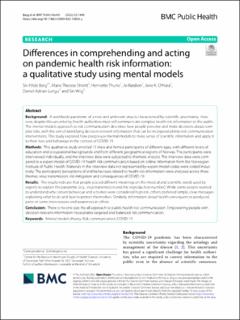| dc.contributor.author | Berg, Siv Hilde | |
| dc.contributor.author | Shortt, Marie Therese | |
| dc.contributor.author | Thune, Henriette | |
| dc.contributor.author | Røislien, Jo | |
| dc.contributor.author | O'Hara, Jane K | |
| dc.contributor.author | Lungu, Daniel Adrian | |
| dc.contributor.author | Wiig, Siri | |
| dc.date.accessioned | 2022-08-02T13:12:42Z | |
| dc.date.available | 2022-08-02T13:12:42Z | |
| dc.date.created | 2022-07-29T18:58:24Z | |
| dc.date.issued | 2022-07 | |
| dc.identifier.citation | Berg, S.H., Shortt, M.T., Thune, H., Røislien, J., O'Hara, J.K., Lungu, D.A., & Wiig, S. (2022) Differences in comprehending and acting on pandemic health risk information: a qualitative study using mental models. BMC Public Health, 22, 1440. | en_US |
| dc.identifier.issn | 1471-2458 | |
| dc.identifier.uri | https://hdl.handle.net/11250/3009806 | |
| dc.description.abstract | Abstract Background A worldwide pandemic of a new and unknown virus is characterised by scientific uncertainty. However, despite this uncertainty, health authorities must still communicate complex health risk information to the public. The mental models approach to risk communication describes how people perceive and make decisions about complex risks, with the aim of identifying decision-relevant information that can be incorporated into risk communication interventions. This study explored how people use mental models to make sense of scientific information and apply it to their lives and behaviour in the context of COVID-19. Methods This qualitative study enrolled 15 male and female participants of different ages, with different levels of education and occupational backgrounds and from different geographical regions of Norway. The participants were interviewed individually, and the interview data were subjected to thematic analysis. The interview data were compared to a expert model of COVID-19 health risk communication based on online information from the Norwegian Institute of Public Health. Materials in the interview data not represented by expert model codes were coded inductively. The participants’ perceptions of and behaviours related to health risk information were analysed across three themes: virus transmission, risk mitigation and consequences of COVID-19. Results The results indicate that people placed different meanings on the medical and scientific words used by experts to explain the pandemic (e.g., virus transmission and the reproduction number). While some people wanted to understand why certain behaviour and activities were considered high risk, others preferred simple, clear messages explaining what to do and how to protect themselves. Similarly, information about health consequences produced panic in some interviewees and awareness in others. Conclusion There is no one-size-fits-all approach to public health risk communication. Empowering people with decision-relevant information necessitates targeted and balanced risk communication. | en_US |
| dc.language.iso | eng | en_US |
| dc.rights | Navngivelse 4.0 Internasjonal | * |
| dc.rights.uri | http://creativecommons.org/licenses/by/4.0/deed.no | * |
| dc.subject | pandemi | en_US |
| dc.subject | pandemic | en_US |
| dc.subject | COVID-19 | en_US |
| dc.subject | kognitiv psykologi | en_US |
| dc.subject | cognitive psychology | en_US |
| dc.subject | helsekommunikasjon | en_US |
| dc.subject | healthcare communication | en_US |
| dc.subject | risk communication | en_US |
| dc.subject | risikokommunikasjon | en_US |
| dc.title | Differences in comprehending and acting on pandemic health risk information: a qualitative study using mental models | en_US |
| dc.type | Peer reviewed | en_US |
| dc.type | Journal article | en_US |
| dc.description.version | publishedVersion | en_US |
| dc.rights.holder | © 2022 The Author(s). | en_US |
| dc.subject.nsi | VDP::Medisinske Fag: 700 | en_US |
| dc.source.pagenumber | 15 | en_US |
| dc.source.volume | 22 | en_US |
| dc.source.journal | BMC Public Health | en_US |
| dc.identifier.doi | 10.1186/s12889-022-13853-y | |
| dc.identifier.cristin | 2040100 | |
| dc.relation.project | SHARE - Centre for Resilience in Healthcare: 5091 | en_US |
| cristin.ispublished | true | |
| cristin.fulltext | original | |
| cristin.qualitycode | 1 | |

